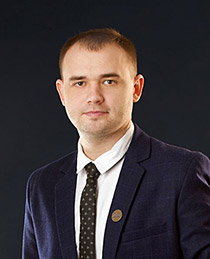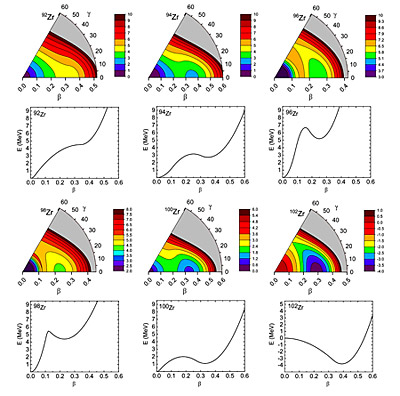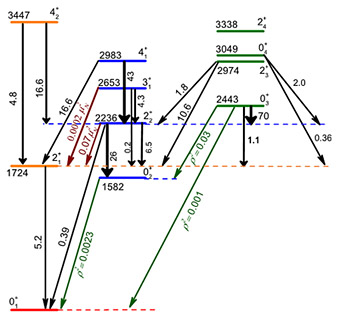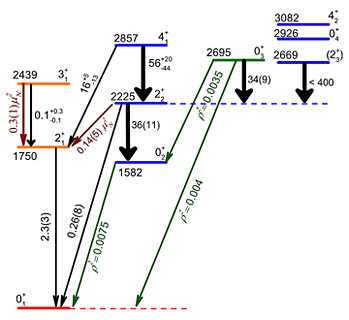
Electronic english version since 2022 |
The newspaper was founded in November 1957
| |
Personal dimension
 Lots of results and even more plans
Lots of results and even more plans
It was 2010, my school years were ending and the Unified State Exam that frightened everyone was gradually approaching. My carefree days were coming to an end, it was time to choose which exams to take. Even in elementary school, I realized that I liked the exact sciences; I had difficulty sitting through classes in humanities subjects such as literature, social studies and so on. As a result, I decided to become a physicist that literally stunned many people around me at that time, including teachers and parents. In addition to the main subjects, I took an exam in physics that I eventually passed with a reasonable number of points. I was faced with a choice of which university to apply to. On one side was Dubna, on the other side was Moscow. I applied in both areas, but as soon as I found out that I got into the Dubna State University, I immediately discarded all other choices. A big role was played by the fact that in Moscow they would not have given me a hostel, so I would have to travel back and forth on train every day.
In my first year, I was very afraid of great difficulties, because I studied at a regular school, without in-depth study of any subjects. This fear forced me to take a hyper-responsible approach to the learning process, as a result of which I passed the first session with flying colors. Afterwards, according to the established system, I closed all subsequent sessions in the same way and eagerly absorbed the teaching material that the teachers gave me. Fortunately for me, most of our lecturers were scientists from the Joint Institute for Nuclear Research. As a result, in my second year, Elena Kolganova, our teacher, brought me to the Bogolyubov Laboratory of Theoretical Physics, for which I am very grateful to her, because I was, as they say, in the right place.
Since my second year, I have already worked as a laboratory assistant at BLTP. Together with several of my classmates, we worked closely with scientists from Charles University in Prague (Czech Republic) that were engaged in positron annihilation spectroscopy.
Positron annihilation spectroscopy allows to examine materials to determine various types of defects. In simple terms, a positron is the antiparticle of an electron; accordingly, due to interaction, these particles annihilate (convert into energy). The annihilation energy is carried away by the resulting gamma rays that can be "seen" using detectors. Thus, the material is irradiated with positrons that annihilate with electrons distributed in the material depending on its defects, then the spectrum of the resulting gamma rays is analyzed that figuratively speaking, sheds light on the defects of the material. For three years, we went on business trips to Prague that caused great delight in my student years. First of all, for it was my first trip, my first flight on an airplane.
As a result, my bachelor's graduation paper was called "Investigation of surface defects using positron annihilation spectroscopy". It is worth noting that the Association of Young Scientists and Specialists played a significant role in learning about the life of the Institute. Thanks to participation in AYSS events, I learned how to make reports and speak at conferences, learned what young colleagues from different laboratories were engaged in, made useful contacts and tried myself as a leader and organizer.
In the master's programme, my research area changed greatly; Elena Kolganova and I began working with Timur Shneidman and Rostislav Jolos. Our group already worked on nuclear physics, namely, the collective model of nuclear physics. As it is known, at present, there is no single theory describing such a complex quantum system as a nucleus. There are many models that focus on describing individual properties of nuclei. These models may be fundamentally different from each other and even be incompatible. Very roughly, nuclear models can be divided into two types: collective and single-particle. Accordingly, the first type describes the nucleus as a whole as a collection of many particles (nucleons), the second type describes the movement of one particle in the field developed by the remaining nucleons that make up the nucleus. My master's thesis was dedicated to the investigation of octupole deformation of nuclei. Nuclei can be not only spherical. They can take other forms (they are called deformations). This could be a quadrupole deformation (when the nucleus is lemon-shaped), it could be an octupole deformation (when the nucleus is pear-shaped) and so on. As a result, my master's thesis was called "Investigation of the occurrence of octupole deformation of atomic nuclei with increasing torque". By the time, I graduated from my master's degree, I was already working as a junior researcher.
In graduate school, I carried out further research in the field of nuclear physics. I gradually prepared my Ph.D. thesis. Along the way, I was offered to give lectures and seminars at my home university. There was a period of my life when I took classes in graduate school and then, ran to give my lectures to 1st and 2nd year students. After completing my postgraduate studies, I studied for a total of 10 years at the Dubna State University and have been still delivering lectures and seminars for 6 years now.
Almost immediately after having completed my postgraduate studies in 2022, I was able to defend my PhD thesis under the supervision of Elena Kolganova and Timur Shneidman on the topic "Investigation of the evolution of quadrupole and octupole deformation of atomic nuclei within the framework of a collective model". Defending my PhD significantly influenced my level of knowledge and my attitude towards work and opened the way to free scientific creativity and doing what I love.
 |
| Fig. 1. Potential surfaces of the Zr isotope chain |
Today, my research areas are very diverse. The basic field of activity is the calculation of the spectra of the levels of the lowest states of nuclei and the probabilities of transitions between them (Fig. 1), as well as the calculation of the collective potential surfaces of nuclei (Fig. 2). I collaborate with experimental groups from the Flerov Laboratory of Nuclear Reactions. I calculate the characteristics of nuclei required for implementing experiments and analyze experimental data. My field of activity includes development of software for meeting collective equations of nuclear physics obtained within the framework of the generating coordinate technique. I study and develop a prototype with a five-dimensional collective equation, a cluster prototype of a binary nuclear system and a prototype of a relativistic average field.


Fig. 2. Calculated (left) and experimental (right) diagram of levels and transition probabilities between them for 96Zr
In the near future, I am going to bring all ideas and developments to publication. It will be great to visit more countries, speak at serious conferences, meet eminent scientists and discuss my results with them. I wish to increase and develop my level of knowledge, I am not going to stop at a PhD. I wish the Joint Institute for Nuclear Research further development and prosperity!
Evgeny MARDYBAN
From the editor
In one of the February issues of the weekly, a new column "Personal dimension" was opened that could be called an auto-essay - an employee's story about how his interest in science has developed, thanks to which the Joint Institute has been chosen as a place of work, how the stages of research careers pass. During this time, not only young scientists, but also specialists from departments supporting the functioning of JINR have joined the initiative. Thanks to our authors, we have learned how the Logistics and Technological Supply Service functions and for the first time on newspaper pages, we talked about the work of the Accounting Department.
"The novelty of such a column in our newspaper," the editor-in-chief of the weekly Evgeny Molchanov says "lies in the fact that scientists and specialists are provided with a kind of platform so that they can talk about their work as they themselves see it, without "pushing" the correspondent to the necessary answers, without retouching, as they say. When editing, we only recommend stylistic editing in terms of newspaper standards or language rules and the editing is carried out jointly, all significant changes are agreed upon.
We have sent to representatives of some of the Institute's services involved in personnel policy and information support a request to write a review about these publications. And we have already received the first answers."
Olga Krupa, a leading analyst of the DSOA expert analytical group:
"Personally, I was very interested to find out exactly how the career path of JINR scientists took shape: what they were interested in during their school years, what university they studied at, what people influenced their choice of profession. When you accumulate more of these stories, you can try to analyze them and describe typical career paths. This would be extremely useful for JINR, including in order to understand what tools to use in order to attract as many talented young people as possible into science."
Alexander Karpov, scientific secretary of FLNR:
"Such personal stories always "give off" the warmth with which the events that have happened to the author are described and awaken an innate sense of curiosity in the reader. When you read them, you are once again surprised by the vicissitudes of fate that sometimes leads us along very intricate trajectories.
We are very grateful to everyone involved in this endeavor, including those that have taken the time to provide feedback. Special thanks to Vladislav Rozhkov that coordinates the cooperation between authors and newspapermen, finds new heroes of publications and resolves controversial situations."
Head of the column Galina MYALKOVSKAYA